Bones reveal Neanderthal child was eaten by a giant bird

Photos: Ancient finds
This wall with paintings is in the La Pasiega Cave in Spain. The ladder shape of red horizontal and vertical lines is more than 64,000 years old and was made by Neanderthals.
Hide Caption
23 of 45

Photos: Ancient finds
These perforated shells were found in Spain's Cueva de los Aviones sea cave and date to between 115,000 and 120,000 years ago. Researchers believe these served as body ornamentation for Neanderthals.
Hide Caption
24 of 45

Photos: Ancient finds
The earliest modern human fossil ever found outside of Africa has been recovered in Israel. This suggests that modern humans left Africa at least 50,000 years earlier than previously believed. The upper jawbone, including several teeth, was recovered in a prehistoric cave site.
Hide Caption
25 of 45

Photos: Ancient finds
This is an excavated structure at the northern edge of the Grand Plaza at Teposcolula-Yucundaa in Oaxaca, Mexico. Researchers investigated a "pestilence" cemetery associated with a devastating 1545-1550 epidemic. New analysis suggests that salmonella caused a typhoid fever epidemic.
Hide Caption
26 of 45

Photos: Ancient finds
Standing about 4 feet tall, early human ancestor Paranthropus boisei had a small brain and a wide, dish-like face. It is most well-known for having big teeth and hefty chewing muscles.
Hide Caption
27 of 45

Photos: Ancient finds
A grand grave of a great Viking warrior excavated during the 1880s has been found to be that of a woman. She was also buried with a gaming board and pieces, hierarchically associated with officers to use for battle strategy and tactics. The drawing is a reconstruction of how the grave with the woman originally may have looked.
Hide Caption
28 of 45

Photos: Ancient finds
An illustration shows the dodo on Mauritius near the Mare aux Songes, where many dodo skeletons have been recovered.
Hide Caption
29 of 45

Photos: Ancient finds
A 5,000-year-old dog skull found in Germany underwent whole genome sequencing. It was found to be very similar to the genome of modern dogs, suggesting that all modern dogs are direct ancestors of the domesticated dogs that lived in the world's earliest farming communities in Europe.
Hide Caption
30 of 45

Photos: Ancient finds
Razanandrongobe sakalavae, or "Razana," was one of the top predators of the Jurassic period in Madagascar 170 million years ago. Although it looks different from modern-day crocodiles and had teeth similar to a T. rex's, Razana was not a dinosaur but a crocodile relative with a deep skull.
Hide Caption
31 of 45

Photos: Ancient finds
An artist's reconstruction shows Macrauchenia patachonica, which roamed South America thousands of years ago. Combining a range of odd characteristics from llamas and camels to rhinos and antelopes,Macrauchenia defied clarification until now and has been added to the tree of life. It belongs to a sister group of Perissodactyla, which includes horses, rhinos and tapirs.
Hide Caption
32 of 45

Photos: Ancient finds
This prosthetic device was made for a priest's daughter who had to have her right big toe amputated 3,000 years ago. This surprisingly lifelike toe was made to look natural by a skilled artisan who wanted to maintain the aesthetic as well as mobility during the Early Iron Age. It was designed to be worn with sandals, the footwear of choice at the time.
Hide Caption
33 of 45

Photos: Ancient finds
The oldest fossil remains of Homo sapiens, dating back 300,000 years, were found at a site in Jebel Irhoud, Morocco. This is 100,000 years older than previously discovered fossils of Homo sapiens that have been securely dated. The fossils, including a partial skull and a lower jaw, belong to five different individuals including three young adults, an adolescent and a child estimated to be 8 years old.
Hide Caption
34 of 45

Photos: Ancient finds
Nodosaurs were herbivores who walked on four legs and were covered in tank-like armor and dotted with spikes for protection. But this recently unveiled 110 million-year-old fossil is the most well-preserved of the armored dinosaurs ever unearthed.
Hide Caption
35 of 45

Photos: Ancient finds
Microfossils found in China have revealed what could be our earliest known ancestor on the tree of life. Saccorhytus was a tiny, bag-like sea creature that lived 540 million years ago.
Hide Caption
36 of 45

Photos: Ancient finds
In 2016, researchers discovered ancient collagen and protein remains preserved in the ribs of a dinosaur that walked the Earth 195 million years ago.
Hide Caption
37 of 45

Photos: Ancient finds
By studying the skeleton of this medieval pilgrim, researchers have been able to genotype leprosy. They also discovered that leprosy-causing bacteria have changed little over hundreds of years, possibly explaining the decline in the disease after it peaked in medieval Europe as humans developed resistance.
Hide Caption
38 of 45

Photos: Ancient finds
The discovery of a species that lived 6.6 million years ago in southwestern China suggests that ancient ottershad "wolf-like" proportions, and weighed roughly 100 Ibs. The creature -- whose skull was excavated in Yunnan province -- would have been twice the size of today's otters.
Hide Caption
39 of 45

Photos: Ancient finds
The tail of a 99-million-year-old dinosaur was found entombed in amber in 2016, an unprecedented discovery that has blown away scientists. The amber adds to fossil evidence that many dinosaurs sported feathers rather than scales.
Hide Caption
40 of 45

Photos: Ancient finds
The oldest known sample of the smallpox-causing variola virus was found within the DNA of a 17th century child mummy in 2016. The mummy was found in a crypt beneath a Lithuanian church. The finding shortens the timeline for how long smallpox may have afflicted humans.
Hide Caption
41 of 45

Photos: Ancient finds
For the first time, researchers discovered genomic evidence of malaria in 2,000-year-old human remainsfrom the Roman Empire. The discovery was made in 2016.
Hide Caption
42 of 45

Photos: Ancient finds
Researchers found the first preserved dinosaur brain in history in 2016. They believe it was preserved due to the dinosaur dying in a swamp-like environment which mixed low levels of oxygen -- known to slow decay -- and acidity which can preserve soft tissue for long periods. It is 130 million years old.
Hide Caption
43 of 45

Photos: Ancient finds
An investigation of skeletons buried during the 1665 Great Plague of London revealed the DNA of the bacteria responsible for the disease in 2016. The skeletons were discovered in an ancient burial site during construction of London's Crossrail train line.
Hide Caption
44 of 45

Photos: Ancient finds
Scientists reconstructed the genome of an ancient plague in 2016, which may shed new light on how certain diseases can either mysteriously disappear or continue to evolve and spread. An adult woman's skeleton (on left) and adult man's skeleton (on right) tested positive for the presence of Y. pestis, what researchers believe caused the Justinian Plague.
Hide Caption
45 of 45

Photos: Ancient finds
The fossil skull of the young Diplodocus known as Andrew, held by Cary Woodruff, director of paleontology at the Great Plains Dinosaur Museum.
Hide Caption
1 of 45

Photos: Ancient finds
Two small bones from the Ciemna Cave in Poland are the oldest human remains found in the country. The condition of the bones also suggests that the child was eaten by a large bird.
Hide Caption
2 of 45

Photos: Ancient finds
This artist's illustration shows the newly discovered dinosaur species Ledumahadi mafube foraging in the Early Jurassic of South Africa. Heterodontosaurus,another South African dinosaur, can also be seen in the foreground.
Hide Caption
3 of 45

Photos: Ancient finds
A 73,000-year-old red cross-hatch pattern was drawn on a flake of silicrete, which forms when sand and gravel cement together, and found in a cave in South Africa.
Hide Caption
4 of 45

Photos: Ancient finds
A suite of Middle Neolithic pottery including typical Danilo ware, figulina and rhyta that was used to hold meat, milk, cheese and yogurt.
Hide Caption
5 of 45

Photos: Ancient finds
These four dinosaurs showcase the evolution of alvarezsaurs. From left, Haplocheirus, Xiyunykus, Bannykus and Shuvuuia reveal the lengthening of the jaws, reduction of teeth and changes in the hand and arm.
Hide Caption
6 of 45

Photos: Ancient finds
Eorhynchochelys sinensis is an early turtle that lived 228 million years ago. It had a toothless beak, but no shell.
Hide Caption
7 of 45

Photos: Ancient finds
The leg bones of a 7-year-old, recovered from an ancient Roman cemetery, show bending and deformities associated with rickets.
Hide Caption
8 of 45

Photos: Ancient finds
The famed Easter Island statues, called moai, were originally full-body figures that have been partially covered over the passage of time. They represent important Rapa Nui ancestors and were carved after a population was established on the island 900 years ago.
Hide Caption
9 of 45

Photos: Ancient finds
Researchers stand at the excavation site of Aubrey Hole 7, where cremated human remains were recovered at Stonehenge to be studied. New research suggests that 40% of 25 individuals buried at Stonehenge weren't from there -- but they possibly transported stones from west Wales and helped build it.
Hide Caption
10 of 45

Photos: Ancient finds
The fossil of the newly discovered armored dinosaur Akainacephalus johnsoni was found in southern Utah.
Hide Caption
11 of 45

Photos: Ancient finds
The foot is one part of a partial skeleton of a 3.32 million-year-old skeleton of an Australopithecus afarensis child dubbed Selam.
Hide Caption
12 of 45

Photos: Ancient finds
The asteroid impact that caused dinosaurs to go extinct also destroyed global forests, according to a new study. This illustration shows one of the few ground-dwelling birds that survived the toxic environment and mass extinction.
Hide Caption
13 of 45

Photos: Ancient finds
The remains of a butchered rhinoceros are helping researchers to date when early humans reached the Philippines. They found a 75% complete skeleton of a rhinoceros that was clearly butchered, with 13 of its bones displaying cut marks and areas where bone was struck to release marrow, at the Kalinga archaeological site on the island of Luzon.
Hide Caption
14 of 45

Photos: Ancient finds
This is just one of 26 individuals found at the site of a fifth-century massacre on the Swedish island of Öland. This adolescent was found lying on his side, which suggests a slower death. Other skeletons found in the homes and streets of the ringfort at Sandby borg show signs of sudden death by blows to the head.
Hide Caption
15 of 45

Photos: Ancient finds
The skeleton of a young woman and her fetus were found in a brick coffin dated to medieval Italy. Her skull shows an example of neurosurgery, and her child was extruded after death in a rare "coffin birth."
Hide Caption
16 of 45

Photos: Ancient finds
This portion of a whale skull was found at the Calaveras Dam construction site in California, along with at least 19 others. Some of the pieces measure 3 feet long.
Hide Caption
17 of 45

Photos: Ancient finds
A Stone Age cow skull shows trepanation, a hole in the cranium that was created by humans as as surgical intervention or experiment.
Hide Caption
18 of 45

Photos: Ancient finds
On the left is a fossilized skull of our hominin ancestor Homo heidelbergensis, who lived 200,000 to 600,000 years ago. On the right is a modern human skull. Hominins had pronounced brow ridges, but modern humans evolved mobile eyebrows as their face shape became smaller.
Hide Caption
19 of 45

Photos: Ancient finds
On the left is a 13,000-year-old footprint as found in the sediment on Calvert Island, off the Canadian Pacific coast. On the right is a digitally enhanced image, showing details of the footprint.
Hide Caption
20 of 45

Photos: Ancient finds
A central platform at Star Carr in North Yorkshire, England, was excavated by a research team studying past climate change events at the Middle Stone Age site. The Star Carr site is home to the oldest evidence of carpentry in Europe and of built structures in Britain.
Hide Caption
21 of 45

Photos: Ancient finds
Researchers have been studying Archaeopteryx fossils for 150 years, but new X-ray data reveal that the bird-like dinosaur may have been an "active flyer."
Hide Caption
22 of 45

Photos: Ancient finds
This wall with paintings is in the La Pasiega Cave in Spain. The ladder shape of red horizontal and vertical lines is more than 64,000 years old and was made by Neanderthals.
Hide Caption
23 of 45

Photos: Ancient finds
These perforated shells were found in Spain's Cueva de los Aviones sea cave and date to between 115,000 and 120,000 years ago. Researchers believe these served as body ornamentation for Neanderthals.
Hide Caption
24 of 45

Photos: Ancient finds
The earliest modern human fossil ever found outside of Africa has been recovered in Israel. This suggests that modern humans left Africa at least 50,000 years earlier than previously believed. The upper jawbone, including several teeth, was recovered in a prehistoric cave site.
Hide Caption
25 of 45

Photos: Ancient finds
This is an excavated structure at the northern edge of the Grand Plaza at Teposcolula-Yucundaa in Oaxaca, Mexico. Researchers investigated a "pestilence" cemetery associated with a devastating 1545-1550 epidemic. New analysis suggests that salmonella caused a typhoid fever epidemic.
Hide Caption
26 of 45

Photos: Ancient finds
Standing about 4 feet tall, early human ancestor Paranthropus boisei had a small brain and a wide, dish-like face. It is most well-known for having big teeth and hefty chewing muscles.
Hide Caption
27 of 45

Photos: Ancient finds
A grand grave of a great Viking warrior excavated during the 1880s has been found to be that of a woman. She was also buried with a gaming board and pieces, hierarchically associated with officers to use for battle strategy and tactics. The drawing is a reconstruction of how the grave with the woman originally may have looked.
Hide Caption
28 of 45

Photos: Ancient finds
An illustration shows the dodo on Mauritius near the Mare aux Songes, where many dodo skeletons have been recovered.
Hide Caption
29 of 45

Photos: Ancient finds
A 5,000-year-old dog skull found in Germany underwent whole genome sequencing. It was found to be very similar to the genome of modern dogs, suggesting that all modern dogs are direct ancestors of the domesticated dogs that lived in the world's earliest farming communities in Europe.
Hide Caption
30 of 45

Photos: Ancient finds
Razanandrongobe sakalavae, or "Razana," was one of the top predators of the Jurassic period in Madagascar 170 million years ago. Although it looks different from modern-day crocodiles and had teeth similar to a T. rex's, Razana was not a dinosaur but a crocodile relative with a deep skull.
Hide Caption
31 of 45

Photos: Ancient finds
An artist's reconstruction shows Macrauchenia patachonica, which roamed South America thousands of years ago. Combining a range of odd characteristics from llamas and camels to rhinos and antelopes,Macrauchenia defied clarification until now and has been added to the tree of life. It belongs to a sister group of Perissodactyla, which includes horses, rhinos and tapirs.
Hide Caption
32 of 45

Photos: Ancient finds
This prosthetic device was made for a priest's daughter who had to have her right big toe amputated 3,000 years ago. This surprisingly lifelike toe was made to look natural by a skilled artisan who wanted to maintain the aesthetic as well as mobility during the Early Iron Age. It was designed to be worn with sandals, the footwear of choice at the time.
Hide Caption
33 of 45

Photos: Ancient finds
The oldest fossil remains of Homo sapiens, dating back 300,000 years, were found at a site in Jebel Irhoud, Morocco. This is 100,000 years older than previously discovered fossils of Homo sapiens that have been securely dated. The fossils, including a partial skull and a lower jaw, belong to five different individuals including three young adults, an adolescent and a child estimated to be 8 years old.
Hide Caption
34 of 45

Photos: Ancient finds
Nodosaurs were herbivores who walked on four legs and were covered in tank-like armor and dotted with spikes for protection. But this recently unveiled 110 million-year-old fossil is the most well-preserved of the armored dinosaurs ever unearthed.
Hide Caption
35 of 45

Photos: Ancient finds
Microfossils found in China have revealed what could be our earliest known ancestor on the tree of life. Saccorhytus was a tiny, bag-like sea creature that lived 540 million years ago.
Hide Caption
36 of 45

Photos: Ancient finds
In 2016, researchers discovered ancient collagen and protein remains preserved in the ribs of a dinosaur that walked the Earth 195 million years ago.
Hide Caption
37 of 45

Photos: Ancient finds
By studying the skeleton of this medieval pilgrim, researchers have been able to genotype leprosy. They also discovered that leprosy-causing bacteria have changed little over hundreds of years, possibly explaining the decline in the disease after it peaked in medieval Europe as humans developed resistance.
Hide Caption
38 of 45

Photos: Ancient finds
The discovery of a species that lived 6.6 million years ago in southwestern China suggests that ancient ottershad "wolf-like" proportions, and weighed roughly 100 Ibs. The creature -- whose skull was excavated in Yunnan province -- would have been twice the size of today's otters.
Hide Caption
39 of 45

Photos: Ancient finds
The tail of a 99-million-year-old dinosaur was found entombed in amber in 2016, an unprecedented discovery that has blown away scientists. The amber adds to fossil evidence that many dinosaurs sported feathers rather than scales.
Hide Caption
40 of 45

Photos: Ancient finds
The oldest known sample of the smallpox-causing variola virus was found within the DNA of a 17th century child mummy in 2016. The mummy was found in a crypt beneath a Lithuanian church. The finding shortens the timeline for how long smallpox may have afflicted humans.
Hide Caption
41 of 45

Photos: Ancient finds
For the first time, researchers discovered genomic evidence of malaria in 2,000-year-old human remainsfrom the Roman Empire. The discovery was made in 2016.
Hide Caption
42 of 45

Photos: Ancient finds
Researchers found the first preserved dinosaur brain in history in 2016. They believe it was preserved due to the dinosaur dying in a swamp-like environment which mixed low levels of oxygen -- known to slow decay -- and acidity which can preserve soft tissue for long periods. It is 130 million years old.
Hide Caption
43 of 45

Photos: Ancient finds
An investigation of skeletons buried during the 1665 Great Plague of London revealed the DNA of the bacteria responsible for the disease in 2016. The skeletons were discovered in an ancient burial site during construction of London's Crossrail train line.
Hide Caption
44 of 45

Photos: Ancient finds
Scientists reconstructed the genome of an ancient plague in 2016, which may shed new light on how certain diseases can either mysteriously disappear or continue to evolve and spread. An adult woman's skeleton (on left) and adult man's skeleton (on right) tested positive for the presence of Y. pestis, what researchers believe caused the Justinian Plague.
Hide Caption
45 of 45

Photos: Ancient finds
The fossil skull of the young Diplodocus known as Andrew, held by Cary Woodruff, director of paleontology at the Great Plains Dinosaur Museum.
Hide Caption
1 of 45

Photos: Ancient finds
Two small bones from the Ciemna Cave in Poland are the oldest human remains found in the country. The condition of the bones also suggests that the child was eaten by a large bird.
Hide Caption
2 of 45

Photos: Ancient finds
This artist's illustration shows the newly discovered dinosaur species Ledumahadi mafube foraging in the Early Jurassic of South Africa. Heterodontosaurus,another South African dinosaur, can also be seen in the foreground.
Hide Caption
3 of 45

Photos: Ancient finds
A 73,000-year-old red cross-hatch pattern was drawn on a flake of silicrete, which forms when sand and gravel cement together, and found in a cave in South Africa.
Hide Caption
4 of 45

Photos: Ancient finds
A suite of Middle Neolithic pottery including typical Danilo ware, figulina and rhyta that was used to hold meat, milk, cheese and yogurt.
Hide Caption
5 of 45

Photos: Ancient finds
These four dinosaurs showcase the evolution of alvarezsaurs. From left, Haplocheirus, Xiyunykus, Bannykus and Shuvuuia reveal the lengthening of the jaws, reduction of teeth and changes in the hand and arm.
Hide Caption
6 of 45

Photos: Ancient finds
Eorhynchochelys sinensis is an early turtle that lived 228 million years ago. It had a toothless beak, but no shell.
Hide Caption
7 of 45

Photos: Ancient finds
The leg bones of a 7-year-old, recovered from an ancient Roman cemetery, show bending and deformities associated with rickets.
Hide Caption
8 of 45

Photos: Ancient finds
The famed Easter Island statues, called moai, were originally full-body figures that have been partially covered over the passage of time. They represent important Rapa Nui ancestors and were carved after a population was established on the island 900 years ago.
Hide Caption
9 of 45

Photos: Ancient finds
Researchers stand at the excavation site of Aubrey Hole 7, where cremated human remains were recovered at Stonehenge to be studied. New research suggests that 40% of 25 individuals buried at Stonehenge weren't from there -- but they possibly transported stones from west Wales and helped build it.
Hide Caption
10 of 45

Photos: Ancient finds
The fossil of the newly discovered armored dinosaur Akainacephalus johnsoni was found in southern Utah.
Hide Caption
11 of 45

Photos: Ancient finds
The foot is one part of a partial skeleton of a 3.32 million-year-old skeleton of an Australopithecus afarensis child dubbed Selam.
Hide Caption
12 of 45

Photos: Ancient finds
The asteroid impact that caused dinosaurs to go extinct also destroyed global forests, according to a new study. This illustration shows one of the few ground-dwelling birds that survived the toxic environment and mass extinction.
Hide Caption
13 of 45

Photos: Ancient finds
The remains of a butchered rhinoceros are helping researchers to date when early humans reached the Philippines. They found a 75% complete skeleton of a rhinoceros that was clearly butchered, with 13 of its bones displaying cut marks and areas where bone was struck to release marrow, at the Kalinga archaeological site on the island of Luzon.
Hide Caption
14 of 45

Photos: Ancient finds
This is just one of 26 individuals found at the site of a fifth-century massacre on the Swedish island of Öland. This adolescent was found lying on his side, which suggests a slower death. Other skeletons found in the homes and streets of the ringfort at Sandby borg show signs of sudden death by blows to the head.
Hide Caption
15 of 45

Photos: Ancient finds
The skeleton of a young woman and her fetus were found in a brick coffin dated to medieval Italy. Her skull shows an example of neurosurgery, and her child was extruded after death in a rare "coffin birth."
Hide Caption
16 of 45

Photos: Ancient finds
This portion of a whale skull was found at the Calaveras Dam construction site in California, along with at least 19 others. Some of the pieces measure 3 feet long.
Hide Caption
17 of 45

Photos: Ancient finds
A Stone Age cow skull shows trepanation, a hole in the cranium that was created by humans as as surgical intervention or experiment.
Hide Caption
18 of 45

Photos: Ancient finds
On the left is a fossilized skull of our hominin ancestor Homo heidelbergensis, who lived 200,000 to 600,000 years ago. On the right is a modern human skull. Hominins had pronounced brow ridges, but modern humans evolved mobile eyebrows as their face shape became smaller.
Hide Caption
19 of 45

Photos: Ancient finds
On the left is a 13,000-year-old footprint as found in the sediment on Calvert Island, off the Canadian Pacific coast. On the right is a digitally enhanced image, showing details of the footprint.
Hide Caption
20 of 45

Photos: Ancient finds
A central platform at Star Carr in North Yorkshire, England, was excavated by a research team studying past climate change events at the Middle Stone Age site. The Star Carr site is home to the oldest evidence of carpentry in Europe and of built structures in Britain.
Hide Caption
21 of 45

Photos: Ancient finds
Researchers have been studying Archaeopteryx fossils for 150 years, but new X-ray data reveal that the bird-like dinosaur may have been an "active flyer."
Hide Caption
22 of 45

Photos: Ancient finds
This wall with paintings is in the La Pasiega Cave in Spain. The ladder shape of red horizontal and vertical lines is more than 64,000 years old and was made by Neanderthals.
Hide Caption
23 of 45



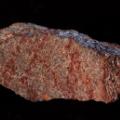



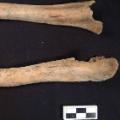

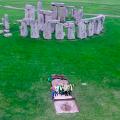

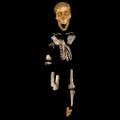

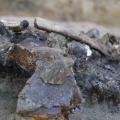
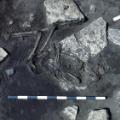
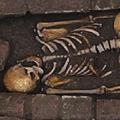
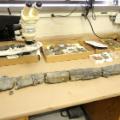
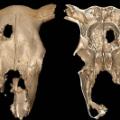
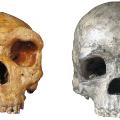
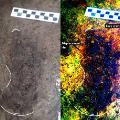

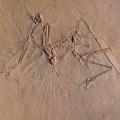
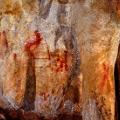
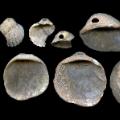
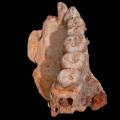

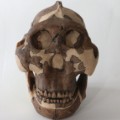
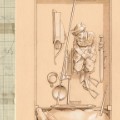
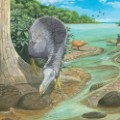
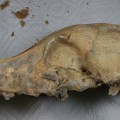
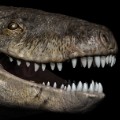

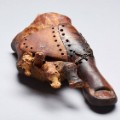
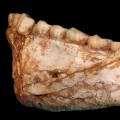
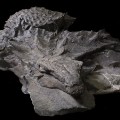
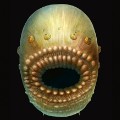
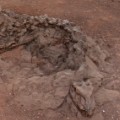


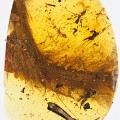





Story highlights
- Dozens of tiny holes on two small Neanderthal hand bones suggest they were ingested
(CNN)When researchers discovered the oldest human remains ever found in Poland a few years ago, they didn't realize that the bones were hiding a grisly secret.
In fact, it wasn't until this year that they realized the bones were human at all, because they were found among animal bones. The researchers discovered that they were human during a lab analysis, according to Science in Poland.
The two tiny phalanges, or digital bones of the hand, are about 1 centimeter long and belonged to a Neanderthal child who was between 5 and 7 years old. The researchers have determined that the bones are 115,000 years old.
Two anthropologists, Anita Szczepanek from Jagiellonian University in Krakow and Erik Trinkaus from Washington University in St. Louis, confirmed the bones as belonging to a young Neanderthal.
An analysis revealed that the bones were covered with dozens of holes, creating a very porous surface. That detail was very telling, the researchers said.
"Analyses show that this is the result of passing through the digestive system of a large bird. This is the first such known example from the Ice Age," said Pawel Valde-Nowak, team researcher and professor at Jagiellonian University's Institute of Archeology, in a statement.
The researchers believe that the bird either attacked and partially consumed the child, or fed off of the child after it died. At this point, it could be either, they said.
Unfortunately, the bones are poorly preserved, which eliminates the possibility of a DNA analysis.
Previously, the oldest human remains uncovered in Poland were three Neanderthal molars estimated to be about 52,000 years old.
The phalanges were uncovered in Ciemna Cave, where excavations have been underway for decades. They were found in a deep layer about 9 feet below the current surface, along with stone tools used by Neanderthals. It is unclear whether the bones ended up in the cave because the Neanderthals lived there or because they used it seasonally.
The findings will be published this year in the Journal of Paleolithic Archaeology.
end quote from:
https://www.cnn.com/2018/10/10/health/neanderthal-child-eaten-by-giant-bird/index.html
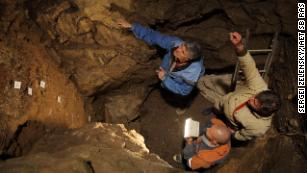
No comments:
Post a Comment